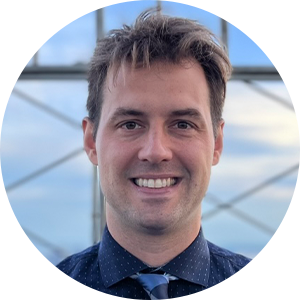Two years ago, cryptocurrency and non-fungible tokens were hyped as life-changing technologies destined to turn the world on its head, sparking a digital Gold Rush unlike anything we’d ever seen. Last year, the metaverse was similarly billed as a revolutionary virtual world designed to alter every part of our lives immediately. This year, 2023, has been all about artificial intelligence, including how AI pertains to higher ed.
Generative platforms, such as ChatGPT, are now capable of producing endless content and even passing state bar exams. Other AI-enabled tech can diagnose an illness, shop online and drive cars. Those are just a few of thousands of estimated AI functions available, and experts predict the number will continue to grow exponentially in the months and years ahead.
AI’s impact has inevitably spread into higher education, affecting the way students approach admissions and schoolwork, as well as how universities teach classes. Most notably, the tech has influenced how colleges are spending their money. More than 15 higher-ed institutions across the United States have announced major plans to invest in AI-related programs, spending oodles of combined dollars to build dozens of new facilities and bring on hundreds of new faculty in the coming years.
But is AI worth the hype, or will it follow in the largely unfilled footsteps of crypto, NFT and the metaverse? Interviewed university leaders, professors and consultants say the answer is somewhere in between.
Big Money, Even Bigger Changes
In May, the University of Southern California announced a massive, university-wide overhaul to integrate AI-focused classes and projects across its 22 schools, recruit more than 60 new faculty members and build an entirely new School of Advanced Computing in the tech-heavy Silicon Beach area of Los Angeles—all by 2030. The “Frontiers of Computing” initiative carries a price tag of $1 billion, making it by far USC’s most expensive project in the university’s 143-year history.
Bill Swartout, chief technology officer at the USC Institute for Creative Technologies, specializes in AI research and has taught at the university for more than 40 years. Although the public viewed artificial intelligence as “a side-fringe field that would never work” for decades, it has now become “a pervasive, powerful tool,” he said. That belief has spurred the coastal school, known for its tech prowess and proximity to Fortune 500 tech giants, to go all-in.
“AI and computing are touching everything we do,” Swartout said. “This project is saying that USC wants to be at the forefront and that we want to leverage the significant background that we have in terms of contributions to computer science.”
At Purdue University, a new project that includes adding 50 new AI faculty over the next five years and building the “Institute for Physical AI” will focus on using AI to improve the agriculture, transportation and manufacturing industries. The Indiana-based engineering school also plans to specialize in detecting “deepfake” videos and making computers that are neuromorphic, meaning they’re designed to model the human brain and nervous system.
Similar to USC, Purdue will spread its new faculty across its 13 different schools. Karen Plaut, the university’s executive vice president for research, said Purdue officials haven’t put out a dollar figure on the program yet because they’re still hoping to expand AI further into the school’s graduate degree offerings. She did concede that the new mega-initiative will be one of Purdue’s biggest-ever expenditures.
“We’re most focused on the physical part of AI,” Plaut said. “We’re asking ‘How does this actually influence things we make that move and that grow?’ It’s a niche that we’re particularly strong in and believe is especially important for the U.S. and the world as we move forward.”
Not all major AI spenders are major international universities, though. At the University of Albany, Provost Carol Kim is overseeing a $200 million injection into the school’s Artificial Intelligence Supercomputing Initiative. The project includes a record cluster hire of 27 new professors, spread out mostly across the university’s STEM majors and the completion of its engineering school building. But the new AI-focused faculty will also be sprinkled out through its liberal arts disciplines.
A Sprint to Raise Money, Take Flight
Interviewed leaders from all three schools emphasized that their respective universities’ timetables are merely loose estimates of when they plan to complete the current rounds of hiring and building. In most cases, securing the required funding involves using every dollar of extra state and federal money, seeking grants and, most importantly, getting donors to contribute. The proposed end dates for the projects are by no means the finish lines.
“It’s a soft rollout in the sense of being incremental and adapting as we go,” Swartout explained. “Ideally this is something that won’t be finished, in the sense that it will always be looking for new areas to grow into and new things to do. AI is such a vibrant, living breathing field, that we can’t just say ‘On October 24, we’ll be done.’”
In the meantime, the schools have wasted no time making their new hires and kicking off as many new programs as quickly and feasibly as possible.
At UAlbany, all 27 new hires are already on campus and teaching, Kim said. The school used the entire $5.2 million of new state funding last year, given to all public universities in New York, to secure and onboard the new faculty within months of announcing its mega-AI initiative last fall. An additional $75 million grant from New York State, specifically for the college to finish its school of engineering and AI supercomputing cluster, helped make the project a reality.
Albany took the “right-now” approach to AI because of the field’s rapidly evolving nature, Kim said.
“It allows us to really make a splash,” she said. “The faculty and supercomputing cluster are key to expanding and enhancing our expertise.”
Similar to Albany, Purdue has already started bolstering its online classes with new AI faculty. Plaut said many of the school’s longer-tenured professors have also upgraded their curriculums to incorporate more AI.
“We can’t wait the full five years for this first round to be finished,” Plaut said. “That’s too late.”
At USC, Swartout acknowledged that coming up with $1 billion won’t happen overnight. The university plans to use a variety of state and federal funding and grant money while commissioning donors to cut handsome checks for the new project to take flight. Holly Willis, chair of the Media Arts and Practice Division in USC’s School of Cinematic Arts, said her department has also pursued seed grants to experiment in the field.
“There are pockets of funding available around different practices around research capacities,” Willis explained. “These seed grants have really helped us level up the entire project.”
Making College Fun—and Useful—Again
It’s hard to get through an interview about AI without hearing the words “fun” or “cool” come up at some point during a conversation with education professionals. These are surprisingly lighthearted terms considering the tech’s serious nature and the major financial commitments that schools are making to their respective programs.
But academics and counselors are mostly sold by the tech’s enormous potential, despite what we’ve seen from similarly hyped industries (e.g., cryptocurrency and the metaverse) in recent years. Unlike digital currencies or virtual reality worlds, AI spans the gamut of professional fields. Some predict that just about every career soon will have some involvement with a form of AI. The technology itself also has the potential to create thousands of new jobs.
On top of that, many educators feel AI presents new, enjoyable opportunities for today’s students and professors to create ideas, projects and careers that were unfathomable for those in their shoes just years ago.
“The thing I find fun about this initiative is the excitement that so many people on campus have for it,” Plaut said. “We’ve got lots of students and faculty working in these areas and they’re all coming together in a new way, which is very exciting.”
“No one is an AI expert because AI is always changing,” Tenny added. “We’re all innovators and we’re all pioneers.”
Kelley Tenny is a California-based professor who has taught an AI in Education course at UC Berkeley since last fall. The course is a perfect example of how the tech can benefit both teacher and student. Tenny began her class last September using and teaching about Jasper AI, a primitive chatbot that has existed since 2020. However, Tenny quickly found her students switching to ChatGPT when that platform hit the public sphere a few weeks into the semester.
Before long, Tenny was learning about the platform from her students and adjusting her curriculum to keep up with the rapidly changing landscape. The final assignment, in which she required students to use AI to make a blog, sales letter, marketing copy and a final presentation, was the most enlightening.
“One student was a computer engineer major, but he was a fencer,” she said. “He did his project on a fencing app for people who were being coached in fencing to have a full analysis of their speed and accuracy measured by AI.
A Changing Landscape for All Parties
“The whole experience just reminded me that no one is an AI expert because AI is always changing,” Tenny added. “We’re all innovators and we’re all pioneers. We’re all learning from one another, and that’s what makes it so cool.”
Rod Lembvem is a principal college admissions counselor at IvyWise, a national firm for high school students aiming for admissions at top-ranked U.S. universities. In just one year on the job, Lembvem said he’s noticed a marked change in how students and families are thinking about the future.
“I do think there’s a certain level of hype to it,” he said. “When I talk with students, I see AI as something that’s here to stay and is only going to continue to grow in utility.”
Part of the evidence, Lembvem pointed out, are trends in higher-ed during the past decade that have slowly built to today’s AI-filled landscape.
“We’ve heard a lot in recent years about ‘big data,’ which is very much part of the AI conversation,” said Lembvem. “We’ve had some adaptation in terms or applications of what is ultimately driving some of the changes that we’re seeing.”
But with some saying that AI is going to automate our entire lives and others warning of a tech-influenced doomsday, is AI overhyped–at least a little bit?
The consensus: some of the hype has gone too far, but the technology is here to stay. And the universities spending big bucks genuinely believe it’s worth the massive price tag.
“It’s going to be a powerful tool that changes some jobs and will open up new jobs,” Swartout said. “We absolutely have to prepare the workforce for the new jobs that are opening up.”
“We’re not just talking about ChatGPT, we’re talking about how our cars work, how agriculture works, the basics of society,” Plaut added. “And that will all be improved because of AI. But that’s not the be all, end all. It’s not like we’re all going to sit home in lounge chairs while AI does all of the work.”
Universities Pitch Creativity, Promise Recognition
Demand for AI professionals is higher than ever, with many jobs paying more money annually than some college professors might make in a few years of work. So naturally, universities have needed to get creative in their pitches to bring on and retain AI thought leaders.
Swartout, Willis, Plaut and Kim don’t pretend when recruiting faculty that their schools can compete financially with corporate giants in the private sector. Instead, the universities highlight the opportunity to compete in innovation and be recognized as influential voices in their fields.
“We’re definitely concerned about that,” Kim said, “But as a university, our value is that we’re a place to explore and teach the next generation.”
“The real thing we can offer people is that people can set their own agenda and have an impact on the world and be noted for that impact,” Swartout added. “You go to a corporation and you kind of disappear because the company wants to keep things under wraps, and so it’s difficult to publish. There are lots of issues, and you may not get full credit for what you’ve done. We offer opportunities for people who want to follow a vision or agenda.”
Willis noted that, although USC regularly loses a few faculty to Fortune 500 tech giants such as Google, the university hasn’t had heavy turnover. Besides the private consulting that the university lets its faculty work on the side, professors also have the chance to research across various disciplines and domains within the college.
If that’s not enough, some schools are willing to open the door a little wider.
At Purdue, Plaut and university President Mung Chiang are letting faculty collaborate with companies in the form of a joint appointment, meaning working part-time in a private industry job and teaching part-time teaching at the university.
The school has long allowed its professors to spend up to 20% of their time consulting outside of their Purdue jobs. According to Plaut, university heads designed the new “partnership” model especially to help attract and retain AI pros.
“That’s one of the more novel approaches that we’re starting to look at; also partnering with the state on some of those people,” she said. “Because they really are in high demand, so we have to make it attractive enough that they say ‘this is the place we want to go.’”







